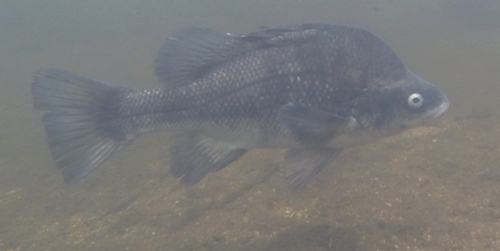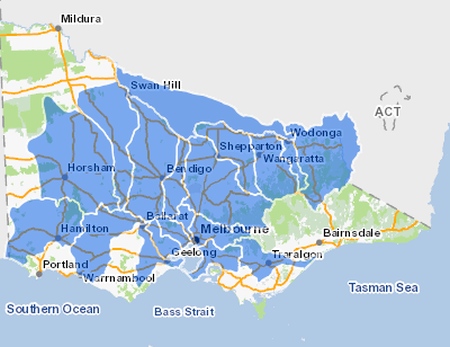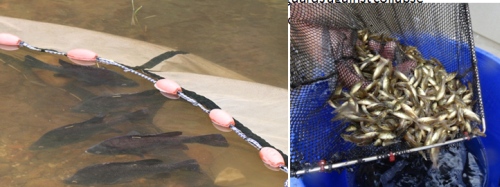Macquarie Perch
Macquarie PerchMacquaria australasica | |
|---|---|
| Kingdom: | Animalia |
| Phylum: | Chordata |
| Class: | Actinopterygii |
| Order: | Perciformes |
| Family: | Percichthyidae |
| Status | |
| Australia: | Endangered (EPBC Act listed) |
| Victoria: | Endangered (FFG Threatened List) |
| Vic FFG: | Listed |

Macquarie Perch are found in Victoria where there are eleven highly fragmented populations in sub-optimal habitat which places their future in doubt. There are also a few remnant populations in New South Wales and the Australian Capital Territory which are thought to be in a worse state than in Victoria.
Distribution

Historic distribution of Macquarie Perch in Victoria. Source: Victorian Biodiversity Atlas, Department of Environment, Land, Water and Planning. Accessed 26/3/2015. Note: many of the populations within this historic distribution comprise fish that were stocked outside their natural range and are no longer present due to cessation of stocking.

Current distribution of Macquarie Perch in their natural range in Victoria except for the Yarra River population which has become a self sustaining population from stockings in the 1920's.
Key Local Government Areas in Victoria where Macquarie Perch are found
Alpine Shire - Buffalo River upstream of Lake Buffalo Conduct fish surveys to monitor population
Benalla Rural City - Holland Creek
East Gippsland Shire and Towong Shire - Dartmouth Dam and Tributaries
Manningham City - Yarra River
Mansfield Shire - Broken River Tributary
Murrindindi Shire - King Parrot Creek, Yea River
Strathbogie Shire - Hughes Creek, Sevens Creek
Wangaratta Rural City - Ovens River
Ecology & Habitat
Macquarie Perch is primarily a riverine species but can establish populations in suitable lakes where fish undergo migrations to riverine habitats in Spring. Lake Eildon and Lake Dartmouth are important impoundments which have been the focus of research into this species.
Spawning habitat comprises pool / riffle sequences where eggs are deposited at the base pools and are washed into riffle areas where they lodge in the substrate.
Connectivity of habitat for migration of adults and dispersal of juveniles from spawning sites requires areas of habitat and refuge pools with adequate depth, boulders, instream wood and an intact riparian zone of native vegetation.
Habitat to maintain productivity and recruitment strength requires natural flow regimes.
Ecology
Macquarie Perch is a long-lived species recorded up to 26 yrs of age (growing to 420 mm TL). Diet comprises aquatic and terrestrial invertebrates. It is a generalist schooling species which can form dense aggregations for several months during the spawning season. Peak spawning occurs in November when temperatures are above 16 °C. There are a number of known key spawning sites where dense aggregations occur. The King Parrot Creek and the Yarra River have been studied during the spawning season.
Macquarie Perch spawning aggregation video by Zeb Tonkin - Arthur Rylah Institute, DELWP, Victoria.
Decline of Macquarie Perch
Construction of dams and weirs which act as a blockage to fish migration has been a major factor in this species decline. In addition, discharge from dams often results in cold water pollution which nullify spawning condition. Dams also prevent connectivity and dislocate populations above and below dams.
Historically, heavy fishing pressure at aggregation sites meant Macquarie Perch were easily taken e.g. “In 1959 and 1960, the Macquarie perch migration coincided with the opening of the angling season. The total catch from the Jamieson and Goulburn Rivers during the opening week of each season was estimated to be 2 – 3 ton of fish” (Cadwallader & Rogan 1977).
Threatening processes
Population fragmentation - populations which now contain low numbers of fish.
Sedimentation - filling critical refuge pools and smothering spawning habitat and eggs.
Catastrophic events - droughts, major floods, bushfires and associated runoff.
Habitat Degradation - instream barriers (including dams), riparian health, desnagging and poor water quality.
Competition/ predation - exotic species e.g. trout, redfin and carp, quantified impacts unknown.
Genetic decline - inbreeding depression.
Conservation & Management
Objectives are focused on preservation of remaining populations, however it is highly likely that some marginal populations will crash particularly in light of climate change projections. There is a need to preserve as many of the current populations as possible while also undertaking long term solutions with objectives focussed on increasing population resilience through:
- Population expansion
- Population connectivity
- Ecosystem health
- Education
Management actions
- Dredging sand from refuge pools.
- Resnaging and replanting riparian zones.
- Removal of exotic species removal (e.g. Sevens Ck).
- Restocking with hatchery bred fish where possible.
- Fisheries regulations and enforcement to protect spawning aggregations.
- Translocation responses to catastrophic events e.g. salvage from streams under sever environment stress and relocation back when conditions become more suitable e.g. the temporary relocation and release of 35 fish from King Parrot Creek and 32 fish from Hughes Creek in March 2009 following drought and bushfires.
- Research to monitor and gather information on the biology and dynamics of Macquarie perch populations. In particular spawning behaviour, population size, recruitment and survivorship.
Goulburn Broken CMA Macquarie Perch Plan 2015
This plan recognises the highly fragmented populations of Macquarie Perch in the Goulburn - Broken Rivers system with a key objective of increasing the resilience of several populations by expanding populations downstream into Goulburn River and Lake Eildon through improving connectivity between Hughes Creek, King Parrot Creek and Yea River.
Catchment managers from the GBCMA, engineers, geomorphologists, hydrologists, ecologists and landholder / local community have worked together to investigate and formulate means of improving connectivity.
North East Victoria - Ovens River project
This project is aiming to create a new self-sustaining population of Macquarie Perch in the Ovens River. The Ovens River once supported an abundant population of Macquarie Perch which had become locally extinct. The project proceed on the basis that the river is large, unregulated with good connectivity and habitat. The project is also supported by the North East Catchment Management Authority works programs and has good levels of community support.
The plan includes a minimum 5 years stockings and 2 year translocation (2013 – 2018)
- Fisheries Victoria hatchery production (10 000 – 40 000 fish / year)
- 2 years translocated fish from Lake Dartmouth (~300 juveniles/adults)
- The release of fish is planned and monitored through a reintroduction plan to safe-guards against collapse. The goal is to have >1000 adult females to reduce chance of population collapse.

Monitoring of Macquarie Perch in the Ovens River has found that over 70% of the sites monitored showed strong evidence of local recruitment which forms the basis for a self-sustaining population.
The Native Fish Report Card surveys carried out in 2023 and 2024 found a large increase in the number of adult fish. Also, there is now evidence that the range of Macquarie Perch in the Ovens River has extended upstream of Wangaratta. (NFRC Ovens River 2024)
Lake Dartmouth
Dartmouth Dam acts as a barrier to the downstream expansion of the population into areas this species historically occupied.
The population in and upstream of the dam had been in decline but since 2008 monitoring indicates the population has been reinvigorated as the lake has begun to fill, providing more food. However, there is concern over the rate of spawning as it appears that only a small proportion of the population is spawning annually.
The filling phase has also led to increased resources for exotic species such as carp and trout, however their impact on the Macquarie Perch population is unknown at this stage.
Yarra River
Melbourne Water has been actively involved with improving overall river health and spawning conditions for Macquarie Perch through the use of environmental flow management. There is on-going monitoring and population modelling to provide optimum conditions for Macquarie Perch recruitment.
Hughes Creek
A high abundance of carp and increased sediment loads resulting in large deposits of sand are the two main threats to Macquarie Perch within Hughes Creek. Fish surveys of Macquarie perch have been conducted in Hughes Creek since 2006. These surveys are vital in detecting population trends and responses to anthropogenic influences. A survey in March 2013 found an increase in Macquarie Perch abundance compared to the previous year but there appears to be limited recruitment, possibly because of sand slugs which can smother eggs during the spawning season. A reduction in connectivity could also be having an impact on spawning as sand slugs have severely reduced instream habitat.
Macquarie Perch: threats, actions and recovery in the Goulburn Broken Catchment. DELWP 1 Dec. 2016
Buffalo River
The Buffalo River near Abbeyard in North Eastern Victoria is considered to be a very important area for Macquarie Perch. As a result of extensive fires in January/February 2020 and a risk that the river would become unsuitable habitat due to sedimentation and ash being washed into the river from burnt out areas an emergency rescue program was undertaken. The rescue effort is part of the Victorian Government’s Bushfire Biodiversity and Recovery Program.
An emergency rescue of 15 Macquarie Perch was undertaken in February 2020 involving relocation to secure and controlled holding facilities at the Victorian Fisheries Authority hatchery at Snobs Creek. The fish will be released back into the Buffalo River when conditions in the catchment have stabilised.
Emergency rescue of Macquarie Perch from fire affected sites in the Buffalo River. Video source: DELWP.
Kiewa River reintroduction
In 2024, scientists from the Arthur Rylah Institute translocated 96 juvenile Macquarie Perch from Lake Dartmouth to the Kiewa River. This translocation means Macquarie Perch are back in the Kiewa River after not being recorded for the past 85 years. An on-going plan to sustain the population will involve stocking captively bred juveniles into the Kiewa River.
More Information
- Research updates on Maquarie Perch from ARI
- Cadwallader, P., & Rogan, P. 1977. The Macquarie perch, Macquria australasica (Pisces: Percichthyidae), of Lake Eildon, Victoria. Australian Journal of Ecology Volume 2, Issue 4, pages 409–418, December 1977
- Department of Environment, Species profiles and threats database - Macquarie Perch
- Victorian Recreational Fishing Regulations - Macquarie Perch

